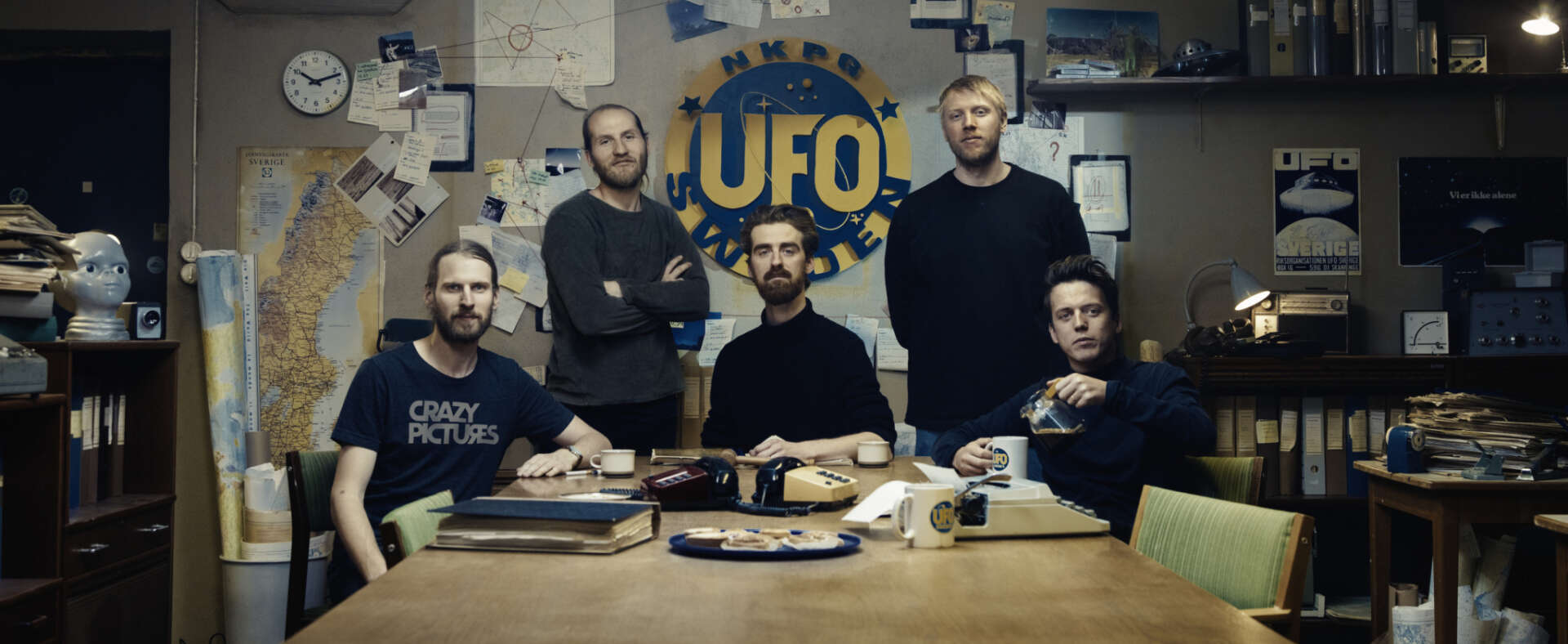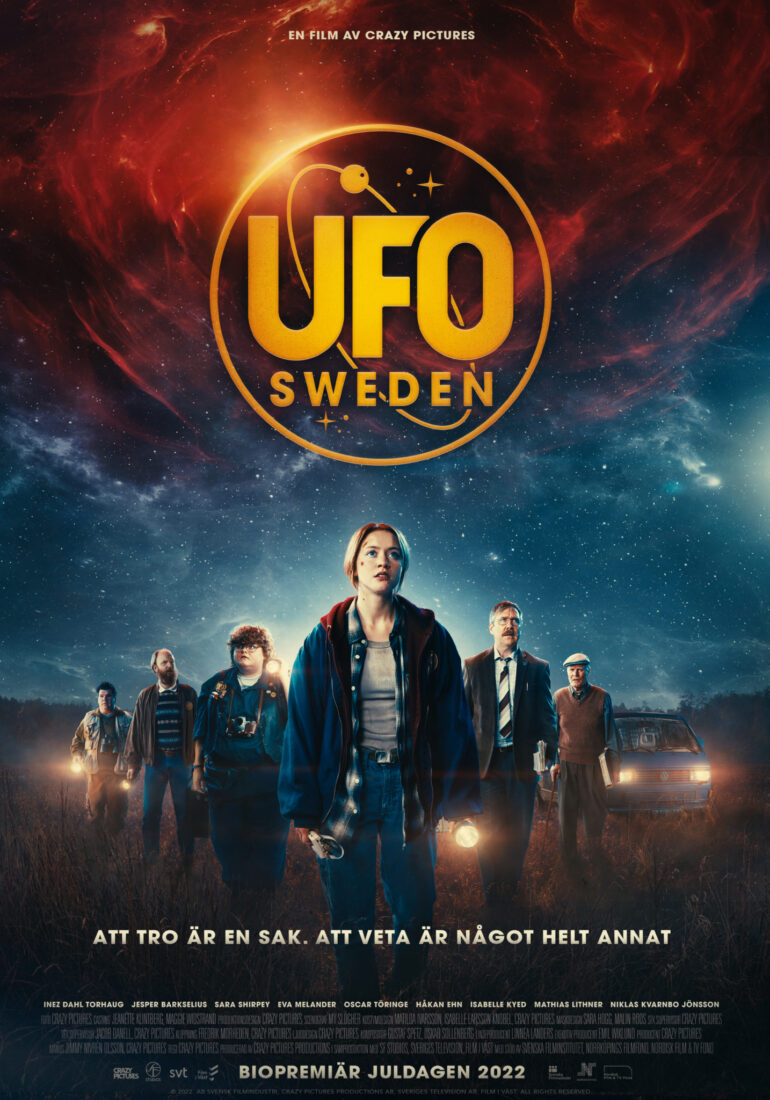
In this exclusive interview, Albin Pettersson, co-founder of the Swedish film collective Crazy Pictures discusses the making of UFO Sweden, set to open December 25 via SF Studios.
Far away from Hollywood, and 160km southwest of Stockholm is the city of Norrköping and home to Crazy Pictures, the film collective set up in 2008 by five high school friends, crazy about genre movies and sci-fi: Olle Tholén, Rasmus Råsmark, Albin Pettersson, Victor Danell and Hannes Krantz.
The famous 5 of small-town Sweden have developed a know-how to create home-made entertaining SFX-VFX-driven films for youth, in a cost-effective way.
After their action-packed short films Poetry for Fish which garnered million views on YouTube, the team with a ‘can do attitude’ created their first feature film The Unthinkable, a thriller disaster movie, made for SEK18.5m (€1.6m), outside the public financing model (see our separate story: CLICK HERE). Picked up by SF Studios, the film ended up selling more than 115,000 tickets in Sweden and was sold to more than 100 territories worldwide.
UFO Sweden which opens on Christmas day in Sweden is their sophomore feature, produced this time on a SEK 38m (€3.4m) budget, in co-production with SF Studios, Film i Väst, SVT, support from the Swedish Film Institute, Norrköping Film Fund, and Nordisk Film & TV Fond. The film was pre-sold by REinvent to several territories including Germany (Telepool), Spain (A Contracorriente Films) and Hungary (Vertigo).
The Stranger Things meets The X-Files Swedish flick follows the young teen rebel Denise, who is placed in foster care after her dad went missing. The young girl who believes her father was kidnapped by UFOs, gets in touch with the local association UFO Sweden. Together, they start to investigate what might have happened to Denise’s dad, with the police never far from them.
In the starring roles are newcomer Inez Dahl Torhaug (The Truth Will Out) in her first major screen role, Jesper Barkselius (The Unthinkable, Rebecka Martinsson), Eva Melander (Border), Sara Shirpey (Out of Touch, Top Dog) and Oscar Töringe (The Thin Blue Line).
The film has just received a double Guldbagge nomination for the editing (from Crazy Pictures and Fredrik Morheden) and the special effects (Crazy Pictures and Jacob Danell).
We spoke to one of the five founders Alvin Pettersson.
Firstly, could you summarise how Crazy Pictures was set up? Are you all simply sci-fi nerds who got together to make the movies you love?
Albin Pettersson: Yes we are a group of friends from high school. We used to make a lot of short films with Victor [credited as the director of UFO Sweden], since we were 18 and just continued, along with Olle Tholén, Rasmus Råsmark and Hannes Krantz. We fell in love with the magic of filmmaking, the ability to discover new worlds, new universes. We want to make something out of the ordinary-which is why we love sci-fi, VFX, SFX-driven films.
Then we started our company straight out of school, when we were 19, making commercials, YouTube films. One was called Poesi för fiskar (Poetry for fish), which got millions of views. That was our first meeting with an audience.
How do you work together?
AP: We have separate positions, working across direction, production, scriptwriting, cinematography, production and sound design, visual effects, practical effects, editing. Personally I’m more involved in production. But we see ourselves as a rock band, playing live. We’re just a group, doing everything together, sometimes changing instruments. Then our films are made inside the four-walls of our studio 1,000+ studio and offices in Norrköping
What is your recipe to deliver spectacular and visually-driven films for under €4m?
AP: We try to make it as smartly as possible. We are responsible for the VFX, practical effects and we think about it from script stage, so it’s all planned, storyboarded in advance. We know what is possible or not possible from development and stick to our plan to stay within budget and to keep control. This is key. Then of course, we collaborate with various companies but fully run the show. Sometimes there are conflicts while creating practical or visual effects, but we focus on making the best film possible. If we have to spend a bit more to make the film look better, we will do it.
Here, we did more practical effects than ever before. We had four scenes with visually difficult elements, and the end scene for instance is 40% practical, 60% digital. Our goal is to make as much on camera as possible. We’re not fans of CGI. We prefer finding alternate solutions, notably with miniatures.
Where did you learn the ropes of practical effects/VFX creation?
AP: The best school for us was the behind-the-scenes of the Lord of the Rings trilogy. That was a big inspiration. Then we learnt with trial and errors, by doing it over the years!
Can you explain how you used the sci fi genre trope not to tell an alien invasion story of bad vs good guys but a character-driven relatable story, with a teen girl who looks for answers in the outside world, to then understand herself?
AP: We found a documentary called Ghost Rockets, about a real organisation called UFO Sverige [UFO Sweden]. We realised this organisation has their archives in Norrköping where we live and discovered it’s the largest UFO archive in the world! We went to visit them and fell in love with those guys-They have a normal life, jobs, but in their spare time, they’ve set up this association. They are really looking for the BIG answers in the universe. If you see anything unusual in the skies, you can call them and they will check it out [www.ufo.se).
It was such an inspiration for us to see these little people searching big answers to life on earth. So from there, we started developing ideas. The character of Denise was there from the beginning, but not in the lead. But when we did make her the main character, all the pieces fell together. Her father goes missing and she goes to UFO Sweden to find answers. It’s really a film about family bonding. She looks for her dad and meets this new bunch of people at UFO Sweden who become her family.
But indeed, our intention was never to do an alien invasion movie, with space ships, the world on the brink of destruction by unknown forces. We had versions of the script that was more a Hollywood-style 80s sci-fi, then it was more of a Swedish criminal movie. It wasn’t easy to find the unique angle.
UFO Sweden combines everything we love - suspense, comedy elements and sci- spectacular parts from our favourite films and series. We were inspired for instance by Stranger Things for the hopeful tone, group of kids and cool elements. But of course, Steven Spielberg’s E.T., Close Encounters of the Third Kind and J.J. Abrams’ Super 8 were big inspirations.
Why did you set the story in the 1990s?
AP: We love the nostalgia. We have seen a lot of movies from the 80s, and felt it was cool do to something set in the 90s. Also, the 90s were when the digital technology emerged. Denise the main character is a techno-geek, whereas her UFA Sweden friends have no idea how a computer works. We felt it was fun to put them together.
How was the casting process? How did you find Inez Dahl Torhaug, your Denise?
AP: We knew that if we could find the right Denise, we would have a good movie. We hired Sweden’s top casting agent for youth and child Maggie Widstrand [Let the Right One In, Snabba Cash, Riding in Darkness]. We looked all over Sweden. Maggie selected 30 youngsters initially; Ina was the first one we looked at and immediately fell in love with her. When we met her in person, we realised she had much knowledge also behind the camera, as her parents are actors as well. But it was tough for her as she was only 17 when we made the movie She had to juggle between school and the shooting. This is her first major feature film.
For the other main role of Lennart, we cast Jesper Barkselius who was in our previous film The Unthinkable. He is just a wonderful actor and person. We needed a great human being who would take care of the young actress playing Denise, as they have so much screen time together. He did just that!
What about the editing and the music, that very efficiently sets the fast-pace and sense of thrill?
AP: We worked with composer Gustav Spetz [So Damn Easy Going] who collaborated with Oskar Sollenberg. We’ve known Gustav for 10 years. He was also attached to The Unthinkable. Then for the editing, for the first time we worked with an external editor, one of the best in Sweden - Fredrik Morheden [A Man Called Ove, Breaking Surface). It was a wonderful experience.
How was the financing this time around?
AP: Unlike for our first movie, made on a shoe-string budget and crowdfunding, as industry people didn’t believe in it at the beginning, this time it was a lot easier and we went through the traditional public support model, with SF Studios as main co-producers. When you make a movie like that, people need to feel secure with the script, which was solid, and when you lock the edit. Here, when we did a test screening for the co-producers, it went super well. People loved it. Then the film was pre-sold to several countries through REinvent.
SEE THE TRAILER
What is your mid-term plan with Crazy Pictures and what’s your next project?
AP: We will continue to develop new films and hope to get started with the next one probably in January. It will be along the same lines as UFO Sweden, about small people thrown in a big adventure, mixing the personal and spectacular.
What about a sequel to UFO Sweden?
AP: Yes-maybe!
…And drama series?
AP: Our filmmaking process is quite slow. With The Unthinkable, we shot it in 120 days. This one was shot in 60 days and post-production took nearly a year. We feel a series would take too much time - unless we changed our working process. We keep our options open, but for now feature film is our main focus, whether this is for a streamer or cinemas.


